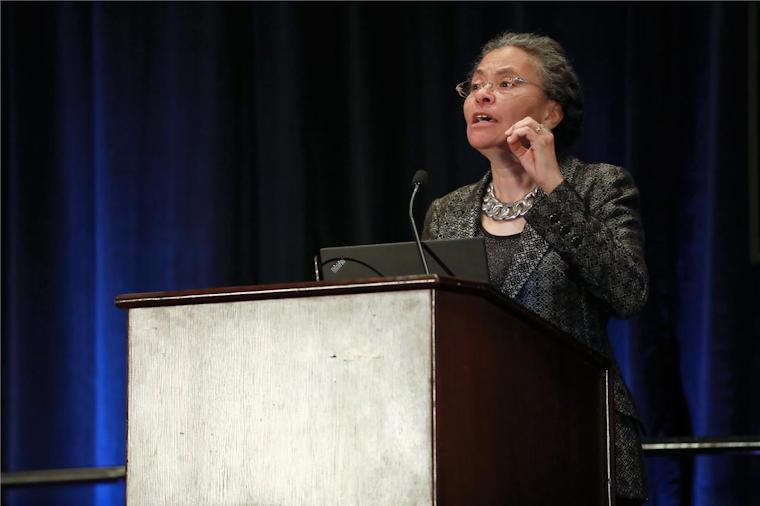Annual Educational Conference attendees looking for a stimulating discussion found all that and more at the featured plenary session, Achieving Health Equity with Dr. Camara Jones, on Friday morning. The session engaged attendees in various dimensions to issues they may not have been aware of, and reignited their energy and passion for issues they care about deeply.
If anyone could stimulate a crowd like a jolt of coffee, it’s Camara Jones, MD, PhD, MPH, immediate past-president of the American Public Health Association, and senior fellow for the Satcher Health Leadership Institute and the Cardiovascular Research Institute at the Morehouse School of Medicine in Atlanta.
Dr. Jones, who presented an ACGME Baldwin Seminar last year, spoke to conference attendees about racism in health care and its impact on the wellness of the US in her lecture entitled, “Achieving Health Equity: Tools for a National Campaign Against Racism.”
She used several different metaphors to address race and racism to illuminate topics that are otherwise typically difficult for many Americans to understand or discuss.
“We must talk about adjustments of social determinants of health,” said Jones using her Cliff Analogy. “Adjusting poverty, adverse neighborhood conditions, and the like, is important if we want to achieve large and sustained improvements in health outcomes. We don’t want everybody pushed up against the edge of a cliff.”
Jones explained that cliff as the “cliff of good health.” Imagine standing on the edge of the cliff and falling off. In some instances, the only means of rescue is an ambulance waiting at the bottom.
“What could we put in place as a health intervention besides an ambulance?” asked Jones. “Let’s put a net half way down. Even if people fall, we can catch them.”
However, a net could have holes in it, and some people may fall through the cracks, Jones noted. A trampoline could include interventions like screenings and early disease detection, but people are still without the resources to tackle the disease and get back to the top of the cliff, she said. A fence might work, representing care, including immunizations and public health awareness programs, to keep people from falling off, but that fence would have to be very strong.
The answer to a good intervention, Jones said, is moving people away from the cliff’s edge.
In the cliff metaphor, the ambulance serves as tertiary prevention, the net and trampoline as safety net programs and secondary prevention, the fence as primary prevention, and moving people away from the cliff as addressing the social determinants of health.
“There is one flaw with this tool,” said Jones. “It does not equip us to talk about how health disparities arise.”
The cliff metaphor, she said, of course must include a focus on interventions, such as safety net programs and primary care, but must also address health disparities.
“We’re talking about racial and ethnic disparities, which have a very long history in our nation, and unfortunately have a lot of evidence of differences in quality of care received within the health care system,” she said.
Health disparities happen due to differences in quality of care, in access to care, and in the conditions of our lives, Jones said.
“At some parts of the cliff, there might be an ambulance, but maybe that ambulance has a flat tire,” she explained. Or maybe there’s a net or fence, but the population is being pushed right up against them.
Jones says doctors need to ask why there are differences in how resources are distributed along the cliff base, and why some populations are pushed closer to the edge.
“We must address the three-dimensionality of the cliff, we must address social determinants of equity including racism, sexism, heterosexism, capitalism, and the like, if we want to achieve social justice and eliminate health disparities,” she said. “All of us must address inequity.”
Dr. Jones explained that health disparities arise due to differences in the quality of care received in the health care system; access to health care, including preventive and curative services; and life opportunities, exposures and stresses that result in differences in underlying health status.
Through a “Gardener’s Tale,” Dr. Jones presented a framework for understanding racism on three levels. This framework is useful for understanding the basis for race-associated differences in health, designing effective interventions to eliminate these differences, and engaging in a national conversation.
In the year 2053, it is projected that there will be no majority racial group in the US. Times are changing, however American medicine looks pretty much like it did more than half a century ago in terms of diversity, with the slight exception of the inclusion of women. Dr. Jones’ session allowed attendees to look at some places that have been blind spots in American medicine, and perhaps individual blind spots within themselves. Because the physicians in training today will be taking care of a population that is radically different from the generation born over 50 years ago, the best way to lead the GME community in the right direction is to start a dialogue and begin to make positive inclusive changes.
Dr. Jones’ session allowed conference attendees to collaborate and share stories, and to begin to discuss potential solutions to issues of diversity in health care. Her direct address of a difficult conversation hit hard on the issues with love, compassion, and a sense of joy and hope. Dr. Jones' approach resonated in the room, perhaps reminding attendees of that core foundation of care in medicine (love, compassion, joy, hope), which thanks to a spotlight, perhaps can force necessary progress for health care and for the nation.
ACGME President and CEO Dr. Nasca announced in his CEO address that same morning that the ACGME has convened a task force and galvanized around efforts focusing on diversity and inclusion. More information is forthcoming as the work of this group and its efforts takes shape.

